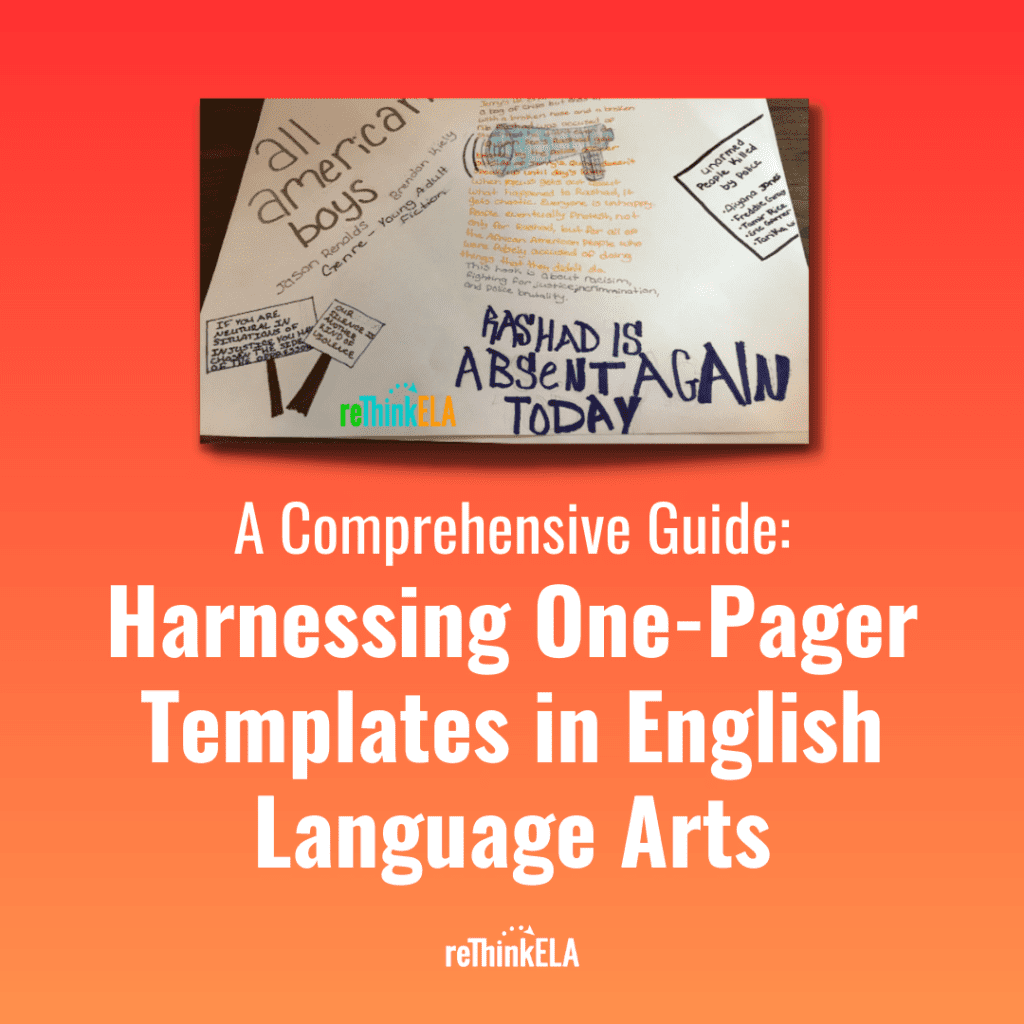
When it comes to enhancing learning experiences in the English Language Arts (ELA) class, incorporating different teaching strategies is the way to go. I know it’s the middle of July and you need to get as much mental rest as possible, but I want to throw these ideas out to you so you’ll have them when you’re ready to start rethinking your lessons for the coming school year. I’m always a fan of thinking about the future and trying to get ahead of the game, though that doesn’t always work the way I think it should.
One often overlooked, yet potent tool, is the one-pager. My colleagues in the Oklahoma Council of Teachers of English first introduced me to one-pager templates about 10 years ago and I was immediately struck by the talent of our art students. However, part of me immediately thought “But I could never create something so amazing...” which led me to think that if I was intimidated by the beauty of some students’ one-pager creations, what about my students whose talents lay outside the arts? Over the years, I’ve had to ask myself, "How can I effectively use one-pager templates in my ELA class when some of my students aren’t artists?" Let's unravel the mystery together.
Advice for using One-Pager Templates in Your English Language Arts Class
One-pagers can serve as a brilliant tool to capture the essence of a text, topic, or theme. In ELA classes, they offer a concise, creative, and visually appealing way to demonstrate understanding and personal connections to the material. Yet students whose strengths are more verbal or kinesthetic may not immediately love the idea of showcasing their artwork So, let's start with some helpful tips.
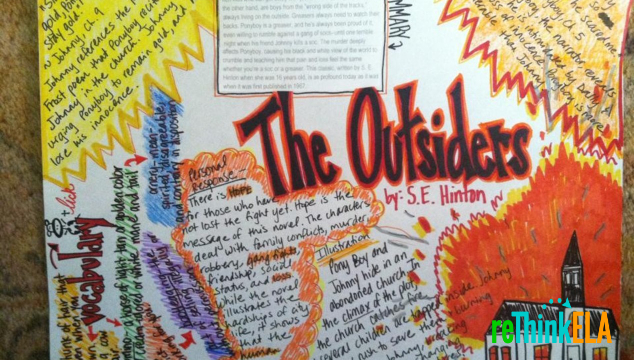
Understanding One-Pagers
It all starts with understanding. A one-pager, as the name suggests, is a single-page response to a piece of text, topic, or theme. This response is not just textual; it blends drawings, doodles, quotes, questions, and personal insights, creating a rich tapestry of learning. Thus, your first step would be to help students understand what one-pagers are and how they offer a unique way to interact with the content. I also ensure that students understand they are not being graded on their artwork, as this is not art class. I am grading on how their work represents their understanding of the text they’ve read.
Not all one-pagers are created equal. Depending on the content or objective, you need to choose the right template. Some one-pagers are purely textual with a layout for quotes, key takeaways, questions, and insights. Others incorporate more visuals and creativity, like flowcharts, infographics, and mind maps. Therefore, choosing a template that aligns with the strengths of your students and your learning objective is vital. For that matter, you may want to set some basic standards, but then let students choose when template they use based on their particular interests.
Download One-Pager Templates
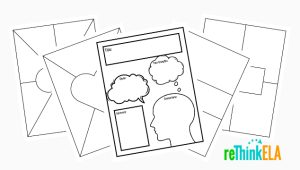
Enter your email address to download five free one-pager templates to empower your students' critical thinking skills and unlock their creativity.
Guidelines over Instructions
While templates provide a structure, it’s essential to ensure that they don't limit creativity. Instead of rigid instructions, provide guidelines that encourage students to express their understanding and perspectives creatively. The key is to facilitate student ownership of their learning process. You can learn more about instructionless lesson design in my podcast interview with Marissa Thompson.
Benefits of One-Pagers in ELA Classes
As you begin to integrate one-pagers into your ELA classes, you will soon notice their numerous benefits. This is especially true if you promote the one-pages as a social activity that will enable students to pool their creativity and understanding so that they can both work and learn together. This process of choosing group members and working together in different roles to create the final product in class promotes social emotional learning, which is especially important for students impacted by school shutdowns in their formative years.
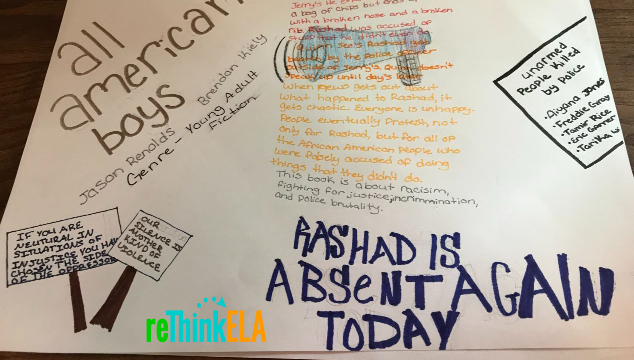
Promotes Comprehension and Retention
Through the process of creating one-pagers, students actively engage with the content. This involvement promotes better comprehension and retention of the material, making it easier for them to recall details and main points. This is especially true when teachers tap into Vygotsky's concept of the zone of proximal development. This theory refers to the gap between what a learner can do independently and what they can do with guidance and support, which is provided through dialogue and collaboration in the learning and problem-solving process.
Those connections are best made combining verbal and visual responses in a collaborative context, but students are struggling. NCTE member Jennifer Bonaldo wrote in March 2023:
One of the biggest challenges I’ve noticed is students struggling to collaborate in small groups. We spent so much time separating them that many have forgotten how to work together.
Enhances Creative and Critical Thinking
By encouraging students to present their understanding in a visual format, one-pagers stimulate creative thinking. Simultaneously, students have to identify key points, make connections, ask meaningful questions, and create non-verbal representations, which enhances their critical thinking skills, according to Allan Paivio’s (1986) dual coding theory. In other words, blending verbal and non-verbal responses in a collaborative assignment will lead to the most powerful results for you and your students.
Just as important, one-pagers can take the stress out of the writing process for reading comprehension assignments and allow students to focus on showing what they’ve understood instead of trying to find the right words to represent what they’re thinking.
NCTE member Jill Yamasawa Fletcher wrote:
The one-pager made the writing component less intimidating, so students were focused more on the ideas in the text. They were not worrying about their transitions or writing a stance or a conclusion. As a result, a lot of anxiety was lifted when we did one-pagers as an assessment.
Fosters Personal Connection
One-pagers allow students to connect personally with the content, making their learning more meaningful. They can express their feelings, ideas, and reactions, helping them connect the text with their own experiences.
Ted Kesler wrote in The Reader Response Notebook:
Rosenblatt (1938) argued that students need to first respond as human beings and share their experiences of a story before a text is used to teach. Literature is not written to teach a strategy but to illuminate life. The first questions to consider are, “What are you thinking? What connections did you make?” rather than “What was the text about?” and “How does the text work?” Personal connections and responses are essential, but not sufficient, as readers also need to dialogue about their interpretations, critiquing those interpretations and examining whether they are supported by evidence from their lives and the text.
One-pagers can help students make those connections from their personal experience to the text in a concrete visual way.
Best Practices for Using One-Pagers in ELA Classes
One-pagers offer a flexible tool to aid learning, but their effectiveness is maximized when used strategically.
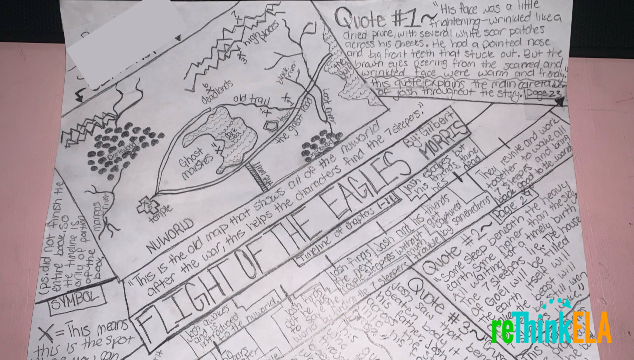
Establish a Purpose
One-pagers can serve various purposes, from summarizing a chapter, exploring a character, to reflecting on a theme. Establish the purpose upfront, and communicate it clearly to the students.
Model the Process
Students might find it challenging to start a one-pager. To help them get started, you can model the process, showing them how you would create a one-pager, how to choose significant points, and how to organize their thoughts. NCTE member Anthony Lince wrote about the first time he modeled his writing process for students:
What my students gained from my modeling session is that mistakes are a normal part of the writing process, a normal part of learning. Modeling our struggles, as educators, can, indeed, be a powerful teaching move, one that we should all consider.
Provide Feedback
Feedback is essential. It helps students understand what they have done well and where they can improve. Remember to highlight the creativity and thoughtfulness reflected in the one-pagers, along with providing constructive suggestions. As a teacher, you can provide feedback through a rubric or via one-on-one or small group writing conferences.
FAQs About Using One-Pager Templates in ELA Classes
One-pagers can be used to cover a wide range of content, including book chapters, poems, short stories, themes, movies, graphic novels, and characters.
Absolutely! One-pagers offer a creative and comprehensive alternative to traditional tests and quizzes. They showcase students' understanding, analysis, and personal connections to the content.
Grading can be based on various criteria such as comprehension of the material, creativity, clarity, neatness, and adherence to guidelines. To reduce student stress levels and encourage creativity, I recommend giving students multiple opportunities to seek help from you, revise their work, and work in groups. A rubric can be a useful tool for this and you can download my group project rubric as part of my bundle of freebies.
Yes, one-pagers can be an excellent tool for collaborative learning. They promote discussion, cooperation, and collective creativity.
Certainly! Digital tools like Google Slides, Canva, or Adobe Express (formerly Adobe Spark) can be used to create digital one-pagers.
The frequency can vary based on your curriculum and objectives. You can use them for specific lessons, at the end of a unit, or as a revision tool.
One-pagers can be a creative and effective tool for enhancing learning experiences in your ELA class. They offer a platform for students to demonstrate their understanding, think critically, and express their creativity. With the right strategies and practices, you can harness their potential to take your teaching to the next level. So, are you ready to incorporate one-pagers in your ELA class?
